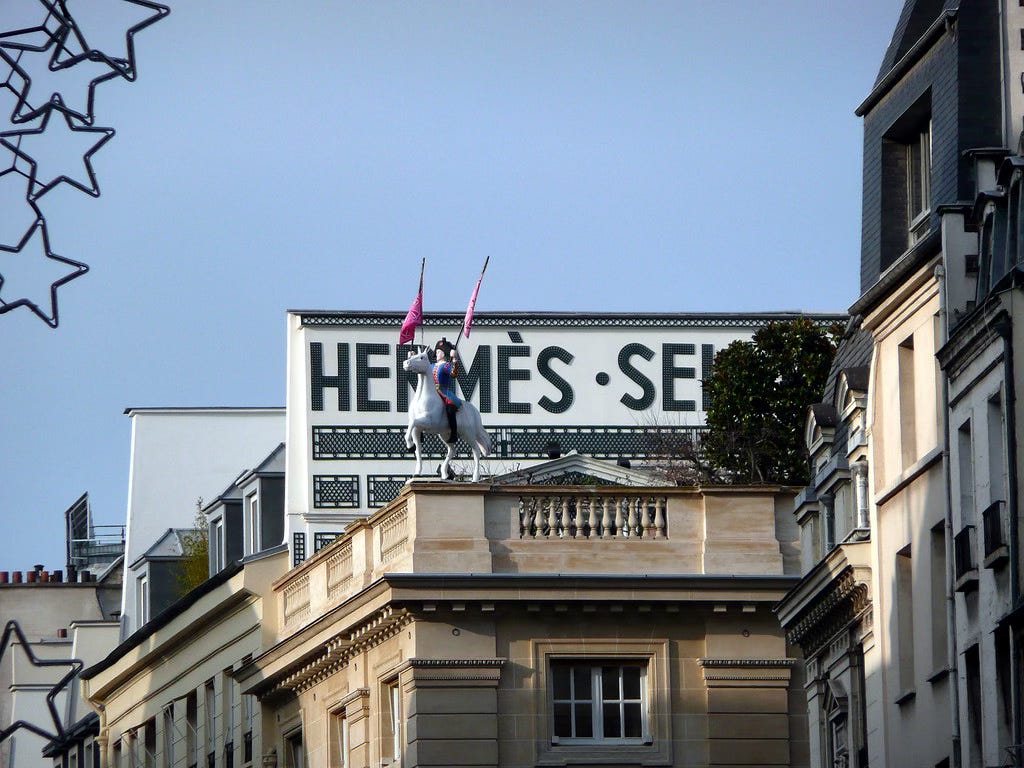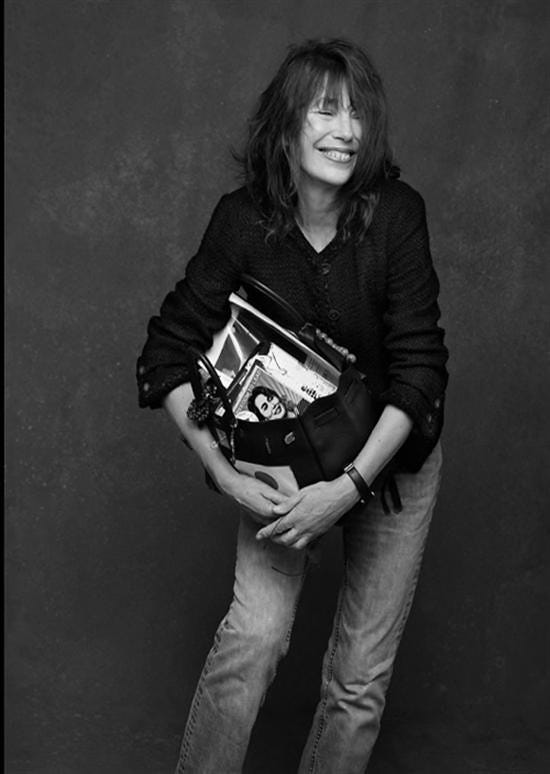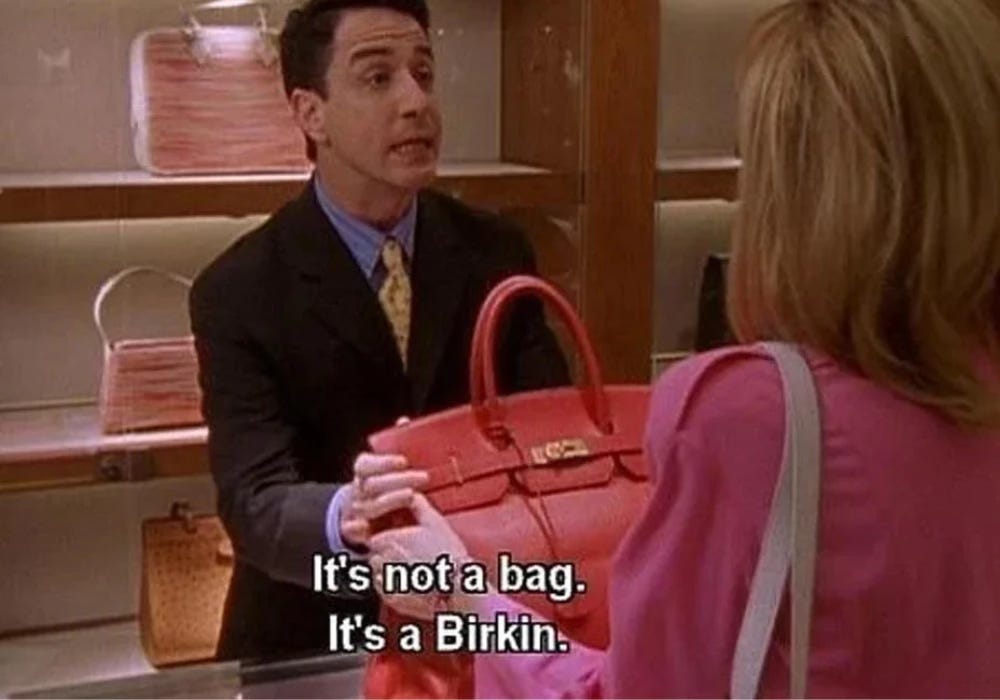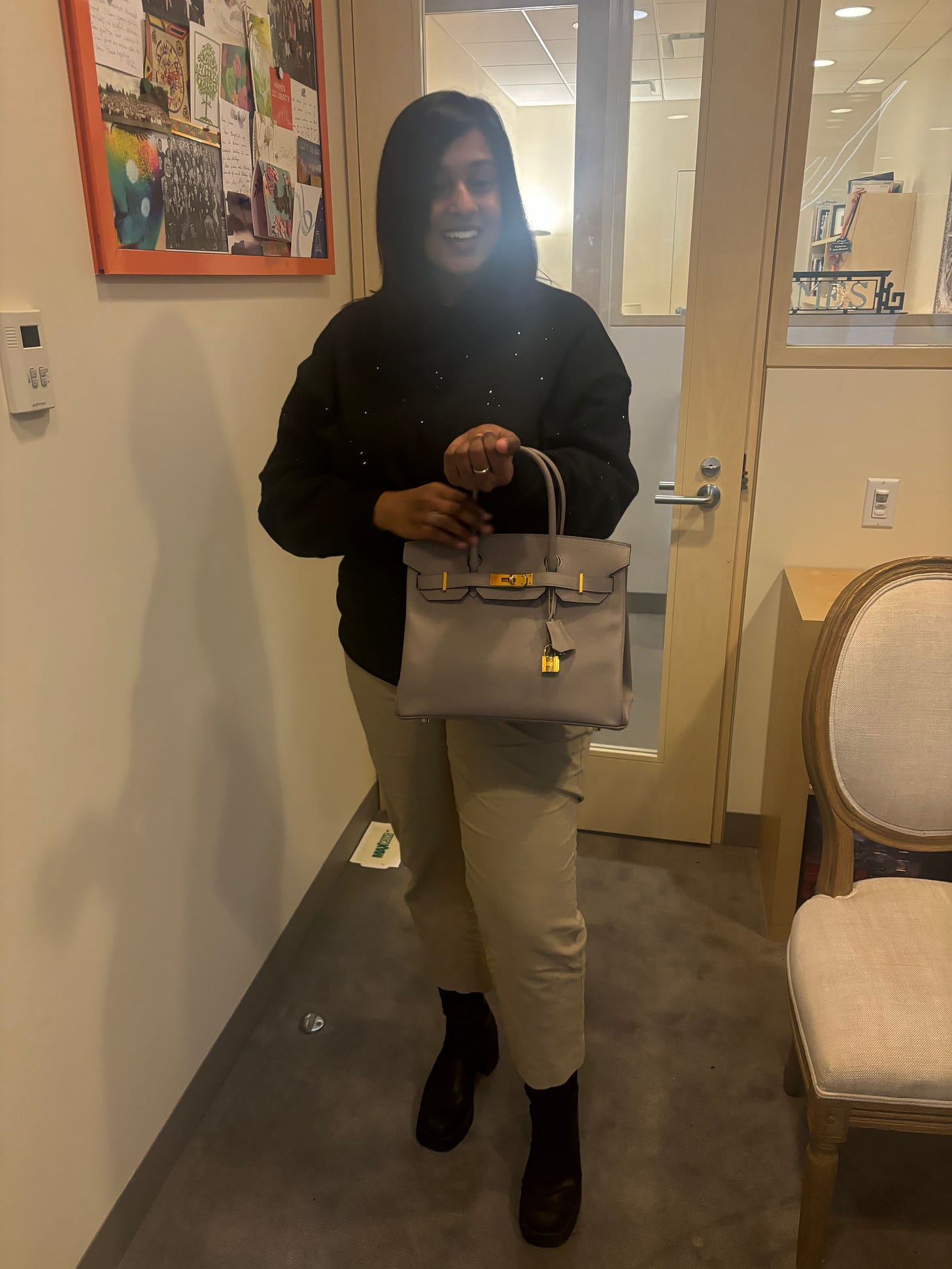How Does it Really Feel to Own a Birkin Bag?
Unraveling the emotional rewards of one of the biggest financial splurge on luxury
“Am I even worthy to own one?”
Monica Anson, 37, gestured to “Grissy,” her Gris Asphalte Birkin, as we chatted at the Hermès Corporate office in New York City. Anson, Manager of Diversity and Leadership at the company, kindly agreed to share the story of acquiring her Birkin 30 with gold hardware—a detail I learned is crucial in describing your Birkin.
The Birkin ranks among the world’s most coveted bags—retailing for anywhere between $8,500 to $200,000 depending on various factors, including the model and materials used. After the headlines in late March about antitrust laws and unfair competition linked to the Birkin bag, I found myself wondering: “What is so special about this bag?”
This wasn't the first time I'd asked this question. Since the beginning of my internship with Hermès earlier this year, I was determined to understand the fascination for the bag. I explored countless articles, watched sumptuous videos about the brand's heritage and craftsmanship, and listened to interviews with artisans—not to mention stories shared directly by my Hermès colleagues. After learning that it takes twenty hours and at least three years of training for a craftsperson to make one Birkin bag, my curiosity only grew. So, when I learned that the person sitting next to me in the office owned one, I knew I had to get to the bottom of my persistent query.
Gathering my courage, I asked her, “Hey Monica, erm, do you own a Birkin?” She laughed and agreed to tell me everything about it.
The origin story of the Birkin is legendary. This ultimate it-bag was conceived from a chance encounter on a flight from Paris to London in 1984, when Jean-Louis Dumas, the then Chairman of Hermès, and actress Jane Birkin got to chatting. Jane, struggling to find a tote that could handle the chaos of young motherhood, aired her woes. Quick on the draw, Dumas sketched a design for a roomy, stylish tote on an airsickness bag. Voilà, the Birkin—with its signature flap, swivel clasp, and straps—was born.
Fast forward to today, and this chameleon of fashion keeps evolving with wild variants like the all-black Birkin So Black, the artsy Birkin Shadow, and the practical Birkin Cargo. Just when you think you know the Birkin, it reinvents itself!
How does Hermès, a brand nearly 200 years old, continue to evoke desire? Contrary to the expectation that higher prices diminish demand, items like the Birkin bag become more coveted as their prices soar, demonstrating the ‘Veblen effect,’ named after the sociologist Thorstein Veblen. This phenomenon highlights the intricate interplay between economics, psychology, and culture in shaping consumer behavior—explaining why shoppers pay higher prices to demonstrate their social cachet. Recalling an episode from Sex and the City, Samantha Jones relentlessly pursues a Red Birkin 35—with gold hardware which revolutionized the conversation around the bag, oops, I mean Birkin, and introduced the concept of the waitlist that could go up to over five years for securing one. Hermès masterfully sells across its sixteen métiers—which not only include leather goods but also Women's and Men’s Ready-to-Wear, Hats, Gloves, Jewellery, Perfumes, Beauty, Fragrance, etc., and store advisors ensure a remarkable experience, fostering long-term customer relationships skillfully having customers coming back for more.
However, despite the crafted scarcity, the Birkin bag maintains a mystique and allure all on its own. There we were—Anson, myself, and the bag, which seemed to possess its own personality. “Whenever I step out with my Birkin, it often steals the show, turning heads and sparking conversations—it's almost like walking with a celebrity,” Anson noted.
Anson was familiar with Hermès long before joining the company eight years ago—her family had a collection of the brand's silk scarves. However, she hadn't always been drawn to the allure of the Birkin bag. “I thought it was ridiculous,” she confessed, reflecting on the extreme lengths people would go to obtain one. It wasn't until she visited the leather workshop in Paris that the charm of the Birkin finally captivated her. Watching artisans meticulously stitch the bags, she was spellbound by the craftsmanship. The high-quality leather, distinctive hardware, and exceptional skill, sprinkled with a dash of artisan sweat and tears, were powerful ingredients for that desire.
Despite the Birkin’s famous waitlist, you'd think that working at Hermès would offer a shortcut to acquiring one. Anson had purchased other items at the biannual employee sale. However, it wasn't until 2019, eight years after joining the company, that she received her golden ticket: an invitation to order a Birkin bag. “I still couldn't see myself buying it, even with a colleague nudging me,” she confessed. Was it the high price? Absolutely. “Owning a Birkin doesn't mean I'm rolling in dough,” she quipped. A few weeks later, the bag arrived at the corporate office, where she and her colleagues, who also received their Birkins, enjoyed a ceremonial unboxing experience.
Psychology tells us that splurging on luxury is often more about emotions than finances. Anson knew it was now or never, and she managed to find what she calls a ‘good deal.’ I'm still not sure what constitutes a ‘good deal’ in the luxury world, but it seems to combine saving money with a strong sense of accomplishment—especially sweet while still working for the company and owning a piece of its legacy. “For me, luxury is about the quality of interactions, not just the goods. It’s about being known by name, the human touch that Hermès embodies,” Anson explained.
Michael Garcia’s introduction to luxury began quite unexpectedly. “I didn’t know a darn thing about brands,” Garcia, a 30-year-old real estate agent shuttling between LA and Dallas, told me. “My luxury awakening happened at the Cheesecake Factory of all places when I spotted someone flaunting a Louis Vuitton. That was my ‘What the heck is Louis Vuitton?’ moment,” he laughed.
As Garcia's bank account grew healthier, so did his appetite for luxury, starting with wallets and eventually escalating to high-end handbags from the likes of Hermès. “I began to invest in myself, and these luxury items are my trophies,” he said. “I don’t go to showings without a nice bag—it’s like my secret weapon. My Blue Paradise Epsom Birkin 30 with gold hardware has sealed deals for me,” he admitted.
However, his shopping experience at Hermès was a mix of emotions. “I just want to grab what I want without having to climb the endless purchase ladder—half of those items I barely use,” he grumbled, recalling having to purchase multiple Clic H bracelets and silks and scouring resale sites for iconic handbags like the Kelly just to catch a client advisor's attention and secure his first Black Birkin 35 with gold hardware. And let's be honest, Hermès isn't handing out Birkins like candy. After all, when something is rare and exquisite, you've got to play the hard-to-get game. This process taps into our deep-seated love for the unattainable—a blend of vanity, self-esteem, and a skewed perception of value.
Yet, echoing Anson's sentiment, Garcia, owner of three Birkin bags, praised the craftsmanship. “The bag just ages beautifully,” he said. “It's like it lives a life alongside you.” This encapsulates the essence of splurging on a high-ticket item—not just for the exclusivity or the immediate status boost, but for the enduring satisfaction it brings.
Casey Lee Collins also discussed the Birkin’s prevailing legacy, sharing how the bag gracefully transitions from one generation to the next. Collins, 35, a business developer at Mark Nelson Designs, found herself with a legacy of luxury—three of her mother's Birkins in need of a little TLC. “When I saw these bags, my first thought was, ‘Oh my God, these need a spa day at Hermès!’” They were definitely showing their age and needed some love," she joked. So she brought the bags to an after-sales service at the Hermès store in Dallas, which restored them. “It was like getting a brand new bag,” she remarked while picking them up three months later.
When it came to acquiring her own Birkin, Collins skipped the infamous waitlist, thanks to her insider knowledge from having worked at an auction house early in her career. “I heard they were auctioning off some Birkins, and I pulled some strings to go into the back room and buy the black Birkin 30 with gold hardware I had been eyeing ever since I saw someone with it in Paris,” she confessed. “If I see something I love, I just go for it.”
For some, splurging on a Birkin is a “Treat yourself, queen” moment. For others, like Anson, it marks a significant milestone. “This Birkin is like a family member, symbolizing my career growth and practicality,” Anson reflected. Meanwhile, Collins is already thinking ahead to the next generation. “I'm so careful with these bags—they're part of my asset portfolio. My two-year-old daughter has started exploring my closet and pulling out the bags. Looks like she's got a taste for luxury too!” she giggled.
It is evident that each of these owners weaves a unique narrative into the fabric of this iconic accessory, demonstrating that the allure of the Birkin goes beyond material value, becoming deeply intertwined with the lives and legacies of those who carry it.
As for me, I'm still waiting for that moment when I feel worthy of owning a Birkin, when I can afford it, and when it symbolizes a milestone in my life. I hope that the bag will continue to be cherished by someone I care about long after I'm gone. Above all, I hope I won't regret splurging on a bag just to say, “I own a Birkin.” Honestly, I want the bag to want me as much as I want it, and I suppose it's not too late to start wanting one now. If anyone would like to gift me one, I'd love a Rose Pourpre Veau Madame Birkin 35—with gold hardware.





